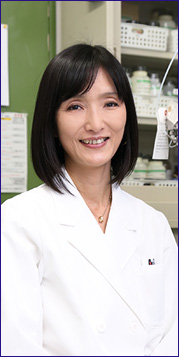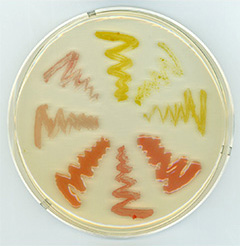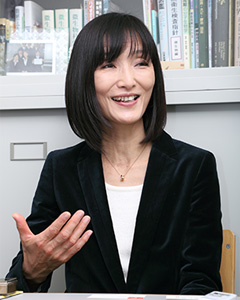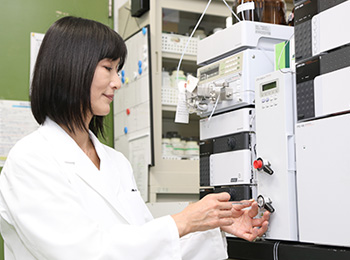

Microorganisms found throughout nature
My field of specialization is microbiology with a special focus on yeasts that are classified as fungi in molecular systematics. Although “yeast” is not formal nomenclature, yeasts are very important in microbiology, industry and research, so fungi of single cell are usually referred to as yeasts.Microorganisms are found everywhere in nature, even in polar zones, equator regions, the deep sea, hot springs, salt farms and so forth, which are extreme environments for us as humans. The microorganisms in these differing environments display great variety in terms of morphology, life cycle, and physiological and biochemical characteristics. They sometimes diversify during evolution, developing the ability to live in their specific environments.
Focus on red yeasts

Red yeasts from the sea producing carotenoids form various red colonies on agar plates
Around the time I started working at Meiji University, our family got its first dog. Because it was our first such experience, we searched for information about taking care of dogs, and we found out that unusually long-lived dogs owned as pets in comfortable environments with food and medical care experienced lifestyle-related diseases and illnesses as they age.
I began to search for microorganisms that produce novel bioactive substances useful for health maintenance and improvement in humans and pets as well as farm animals. At that time, I remembered the red yeasts isolated from the sea: it dawned on me that the red pigments were derived from carotenoids, which are known to be useful bioactive substances for maintaining and improving health!
The sea as an unexplored and insufficiently studied area
It is known that more than 750 kinds of carotenoids are produce by various plants, animals and microorganisms in nature. Some of these carotenoids are well known for their antioxidative effects, and recently it was revealed that some of them also have various physiological effects such as inhibiting the progression of type II diabetic nephropathy, moisturizing the skin, and preventing the formation of melanin caused by ultraviolet rays. Therefore, carotenoids are expected to be used in various fields.
Astaxanthin is a carotenoid that has received much attention in various fields such as dietary supplements and cosmetics. Currently, most astaxanthin is produced industrially using a microalga, whose culture costs a lot because sunlight and very large sections of land are necessary for its growth. On the other hand, astaxanthin production using red yeasts can contribute considerably to cost reductions, because yeasts grow well in inexpensive media without the need for sunlight and large expanses of land. Therefore, I intend to continue screening red yeasts from the sea to produce astaxanthin for the benefit of industry and end users.
Novel discoveries induced from unexpected results
My other research project is a study on the biodegradation of harmful chemicals by microorganisms, which is called bioremediation. Phenol, which is very important in various industrial fields, is our target chemical because it is harmful to ecological and environmental systems when discharged into rivers.
Carotenoids extracted from red yeasts are analyzed for structure and physiological effects
We investigated about 900 yeast strains isolated from mud and animals collected in the sea and found a strain from the deep sea that degrades phenol considerably. We must consider the influence of microorganisms on the environment and establish practical techniques before utilizing microorganisms in polluted areas in nature. Therefore, I intend to continue studying yeast strains in various ways in order to establish basic environmental purification technologies.
In my research, I always maintain a focus on multidimensional analysis because I strongly believe that novel discoveries can be induced from unexpected results. In fact, I know that some novel discoveries have been derived from results that were initially considered to represent failures. Therefore, I usually tell my students to try again even if their experiments do not go well the first time. I find scientific research to be attractive because it offers novel discoveries in unexpected places.
Profile
Professor, Department of Life Sciences, School of AgricultureMakiko Hamamoto joined the Meiji University School of Agriculture in 2004 after serving at research institutes including RIKEN (The Institute of Physical and Chemical Research). She has a Ph.D. in Agriculture from The University of Tokyo.
Applied microbiology, molecular systematics of microorganisms
Kennedy o Daitoryo ni Shita Biseibutsu (joint translation of the book Power Unseen: How Microbes Rule the World, Springer-Verlag Tokyo)









